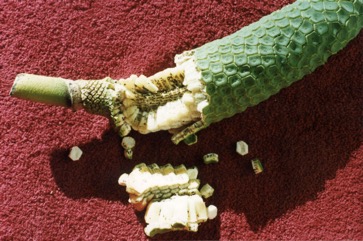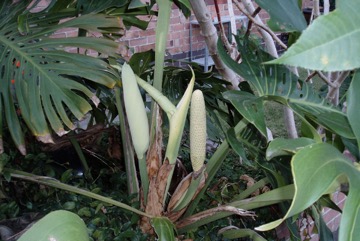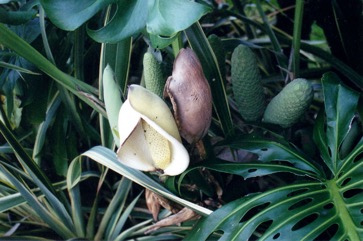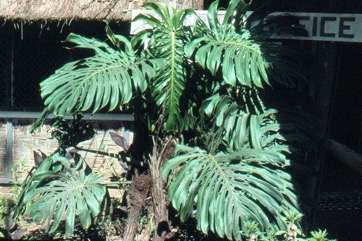Ceriman, Monsteria

A tropical plant. It does best in rich, moist, well-drained soils. It suits a protected, shady position. It bears fruit between 700 m and 2300 m altitude in the equatorial tropics but the plant grows down to the coast. It is damaged by drought and frost. Seed need to be sown at a temperature between 18-24°C. The plant needs a temperature above 15°C. It suits hardiness zones 11-12. In XTBG Yunnan.
Also known as:
Balaco, Balazos, Banana de macaco, Costila de Adan, Cut leafed Philodendron, Fensterblatt, Fruit Salad Plant, Gui bei zhu, Harpon, Makhna, Mexican breadfruit, Monstera, Monstera sedap, Monsutera derishioosa, Pinanona monstera, Pinanona, Swiss-cheese plant
Synonyms
- Monsteria lennea C. Koch
- Philodendron pertusum Kunth & C. D. Bouche
- Rhaphidophora
Edible Portion
- Fruit
Where does Ceriman grow?
Found in: Africa, Asia, Australia, Bangladesh, Brazil, Central America, China, Costa Rica, Cuba, East Africa, Fiji, Guam, Guatemala, Hawaii, India, Indonesia, Korea, Mexico, Mozambique, Myanmar, Nauru, New Caledonia, North America, Pacific, Pakistan, Panama, Papua New Guinea, PNG, Paraguay, Philippines, SE Asia, Slovenia, South Africa, Southern Africa, South America, Sri Lanka, St Helena, Taiwan, Tasmania, Uruguay, United States, West Indies, Zimbabwe
Notes: There are about 40-60 Monstera species.
Growing Ceriman, Monsteria
Cultivation: It is easily propagated by cuttings. Stem cuttings with one or two nodes or eyes are used. These are placed horizontally in potting mix. Putting these in a warm place with bright light but not direct sunlight quickens rooting. It should have a trellis, tree or wall to climb against. Plants can be grown from seed. Fruit can be ripened evenly by cutting them as soon as the base starts to ripen then wrapping them in paper for few days.
Edible Uses: The fruit is edible. The fruit are encouraged to ripen evenly by putting in a paper bag in a fridge for 24 hours then ripening at room temperature. The very ripe fruit are eaten. The fruit pulp can be strained and used as a drink. CAUTION The unripe fruit have irritant crystals which sting the mouth.
Production: Plants grown from seeds take 6 years to fruit. The fruit take about a year to mature after flowering.
Nutrition Info
per 100g edible portion| Edible Part | Energy (kcal) | Protein (g) | Iron (mg) | Vitamin A (ug) | Vitamin c (mg) | Zinc (mg) | % Water |
|---|---|---|---|---|---|---|---|
| Fruit | 73 | 1.8 | - | - | - | - | 77.8 |
Ceriman, Monsteria Photos




References
Ambasta, S.P. (Ed.), 2000, The Useful Plants of India. CSIR India. p 379
Bodkin, F., 1991, Encyclopedia Botanica. Cornstalk publishing, p 707
Brown, D., 2000, Aroids. Plants of the Arum family. Timber Press. (Second edition) p 271
Bremness, L., 1994, Herbs. Collins Eyewitness Handbooks. Harper Collins. p 282
Brickell, C. (Ed.), 1999, The Royal Horticultural Society A-Z Encyclopedia of Garden Plants. Convent Garden Books. p 681
Burkill, I.H., 1966, A Dictionary of the Economic Products of the Malay Peninsula. Ministry of Agriculture and Cooperatives, Kuala Lumpur, Malaysia. Vol 2 (I-Z) p 1515
Crandall, C & Crandall, B., 1996, Flowering Fruiting and Foliage vines. Sterling. p 91
Cundall, P., (ed.), 2004, Gardening Australia: flora: the gardener's bible. ABC Books. p 902
Darley, J.J., 1993, Know and Enjoy Tropical Fruit. P & S Publishers. p 121
Facciola, S., 1998, Cornucopia 2: a Source Book of Edible Plants. Kampong Publications, p 25
Flora of Pakistan. www.eFloras.org
Flowerdew, B., 2000, Complete Fruit Book. Kyle Cathie Ltd., London. p 150
French, B.R., 1986, Food Plants of Papua New Guinea, A Compendium. Asia Pacific Science Foundation p 286
Hedrick, U.P., 1919, (Ed.), Sturtevant's edible plants of the world. p 418
Hermandez Bermejo, J.E., and Leon, J. (Eds.), 1994, Neglected Crops. 1492 from a different perspective. FAO Plant Production and Protection Series No 26. FAO, Rome. p14
Hibbert, M., 2002, The Aussie Plant Finder 2002, Florilegium. p 198
http://www.botanic-gardens-ljubljana.com/en/plants
Janick, J. & Paul, R. E. (Eds.), 2008, The Encyclopedia of Fruit & Nuts. CABI p 77
John, L., & Stevenson, V., 1979, The Complete Book of Fruit. Angus & Robertson p 195
Kiple, K.F. & Ornelas, K.C., (eds), 2000, The Cambridge World History of Food. CUP p 1816
Lazarides, M. & Hince, B., 1993, Handbook of Economic Plants of Australia, CSIRO. p 166
Llamas, K.A., 2003, Tropical Flowering Plants. Timber Press. p 84
Lord, E.E., & Willis, J.H., 1999, Shrubs and Trees for Australian gardens. Lothian. p 334
Lorenzi, H., Bacher, L., Lacerda, M. & Sartori, S., 2006, Brazilian Fruits & Cultivated Exotics. Sao Paulo, Instituto Plantarum de Estuados da Flora Ltda. p 365
Lyle, S., 2006, Discovering fruit and nuts. Land Links. p 286
Macmillan, H.F. (Revised Barlow, H.S., et al) 1991, Tropical Planting and Gardening. Sixth edition. Malayan Nature Society. Kuala Lumpur. p 304
Marinelli, J. (Ed), 2004, Plant. DK. p 215
Martin, F. W., et al, 1987, Perennial Edible Fruits of the Tropics. USDA Handbook 642 p 19
Miguel, E., et al, 1989, A checklist of the cultivated plants of Cuba. Kulturpflanze 37. 1989, 211-357
Morton, J. F., 1987, Fruits of Warm Climates. Wipf & Stock Publishers p 15
Pasha, M. K. & Uddin, S. B., 2019, Minor Edible Fruits of Bangladesh. Bangladesh J. Plant Taxon. 26(2): 299–313
Purseglove, J.W., 1972, Tropical Crops. Monocotyledons. Longmans p 59
Recher, P, 2001, Fruit Spirit Botanical Gardens Plant Index. www.nrg.com.au/~recher/ seedlist.html p 2
Segura, S. et al, 2018, The edible fruit species in Mexico. Genet Resour Crop Evol (2018) 65:1767–1793
Standley, P. & Steyermark, J., 1958, Flora of Guatemala. Fieldiana: Botany, Volume 24 part 1 p 330
Staples, G.W. and Herbst, D.R., 2005, A tropical Garden Flora. Bishop Museum Press, Honolulu, Hawaii. p 606
Stone, B. C., 1970, The Flora of Guam. A Manual for the Identification of the Vascular Plants of the Island. Micronesica. Journal of the University of Guam. p 121
Sukarya, D. G., (Ed.) 2013, 3,500 Plant Species of the Botanic Gardens of Indonesia. LIPI p 944
Thaman, R. R., et al, 1994, The Flora of Nauru. Atoll Research Bulletin No. 392. Smithsonian Institute p 42
USDA, ARS, National Genetic Resources Program. Germplasm Resources Information Network - (GRIN). [Online Database] National Germplasm Resources Laboratory, Beltsville, Maryland. Available: www.ars-grin.gov/cgi-bin/npgs/html/econ.pl (10 April 2000)
van Wyk, B., 2005, Food Plants of the World. An illustrated guide. Timber press. p 251
Vidensk. Meddel. Dansk Naturhist. Foren. Kjobenhavn 1849:19. 1849
World Checklist of Useful Plant Species 2020. Royal Botanic Gardens, Kew
Zuchowski W., 2007, Tropical Plants of Costa Rica. A Zona Tropical Publication, Comstock Publishing. p 360